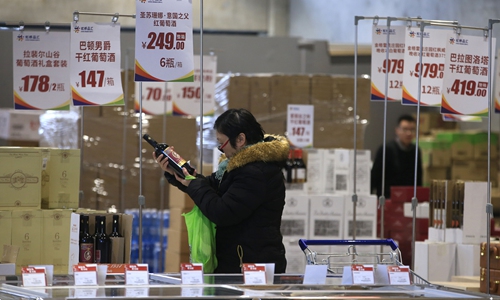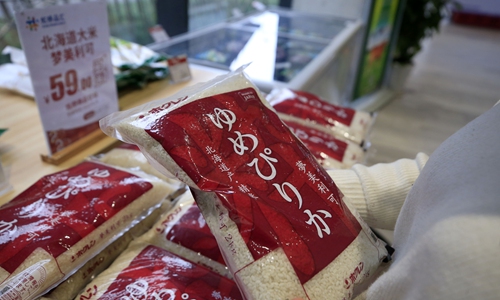A taste for the exotic
Chinese consumers flock to buy wine and food imports ahead of Spring Festival

A customer checks imported wine at Hongqiao Import Commodity Exhibition and Trading Center on January 15. Photo: Yang Hui/GT
A view of imported Japanese rice at the center. Photo: Yang Hui/GT
"It's my second time here. I'm buying imported wines because Spring Festival is coming up," a customer surnamed Wang told the Global Times in a Shanghai supermarket as she browsed the wine shelves.
Ahead of the Spring Festival, Chinese people are flocking to supermarkets and specialty stores to buy delicacies for the festival.
What are the most popular imported foods and drinks on the table for Chinese New Year?
The Global Times went to investigate what's tempting the taste buds of consumers.
At Hongqiao Import Commodity Exhibition and Trading Center, a center for imported goods in Shanghai, customers were jostling each other as they tried to find the best deals.
Zhu Zhenhua, a retiree with a full trolley, showed off what he had bought: imported olive oil, wine from Spain, rice from Japan and beef from Australia.
"I expect to spend 1,000 yuan ($145) on imported food for the Spring Festival," Zhu said, adding that he comes once a month to buy imported food.
Imported red wine and snacks are most popular products, Xiao Jianwen, who works at the trading center told the Global Times on Sunday.
"Italian and French red wines are most popular. We've sold tens of thousands of bottles from these two countries in a month," he said.
The center has had a month-long sale on certain imported products from December 23 to January 23. The center says that as well as wine, red shrimps from Argentina and white shrimps from Ecuador are the biggest sellers.

Import expo offshoot
As an extension of the China International Import Expo (CIIE), the center positioned itself as the biggest distribution center for imported products in the world that integrates display, commodity trading, logistics storage and customs clearance services.
This center was established after the first CIIE in 2018 to expand the spillover effect of the CIIE and stimulate off-site exhibition with increased opportunities for public participation, Mao Xufei, an employee with the operation department told the Global Times.
The imported food hall now boasts 8,000 products, up from 1,000 a year ago.
Sales of imported food have boomed in the past two years as demand for imported food picked up, Xiao said.
"This year's sales of imported food are much better than last year. The same time last year, the daily sales volume was just thousands of yuan, but now it has soared up to 600,000 yuan a day," he said.
"Last year we had imported food from 30 countries and regions. Now it's 70. Brands from Southeast Asia, Japan and South Korea get the most interest from the Chinese market," he said.
As China pushes to upgrade consumption, tastes have changed, with greater demand for higher-quality imported foods.
A prosperity index released by UK think tank Legatum Institute, shows living standards of Chinese people is improving rapidly. The Chinese mainland shot up from 82nd place in 2018 to 57th place in 2019, according to the Legatum Prosperity Index, which offers a unique insight into how prosperity is forming and changing across the world, using indicators that include wealth, economic growth, education, health, personal well-being and quality of life.
In 2018, the volume of China's imported food grew rapidly, with total imports value reaching $73.569 billion, a year-on-year increase of 19.33 percent, according to the 2019 China Import Food Industry Report.
China imports foodstuffs and beverages from 185 countries and regions. The import value of seafood, meat and dairy products has surpassed the tens of billions of dollars, the report said.
The growth comes as a result of tariff cuts, swifter customs clearance and rising demand from Chinese consumers, according to experts.
"The reduction in tariffs is juxtaposed with the growth of domestic consumption power, which together contribute to the growth in imported products," Huang Jianzhong, a professor with Shanghai University of International Business and Economics told the Global Times on Sunday.
"There were two major rounds of tariff cuts in July and November 2019 which also covered the food sector," he said.
He predicted that imported wine, nuts and chocolate will lead domestic consumption in 2020.
Data released by the General Administration of Customs on January 13 showed that in December 2019, the overall customs clearance time for imports was 36.7 hours, a reduction of 62.3 percent from 2017.
Though the main consumption of imported food is still in first-tier cities, second- and third-tier cities are swiftly catching up, Huang added.
According to Xiao, most of their customers are from Shanghai with a 20 percent coming from other provinces nearby.
"We are now establishing a branch in Chaohu, Anhui Province as demand picks up," he said.